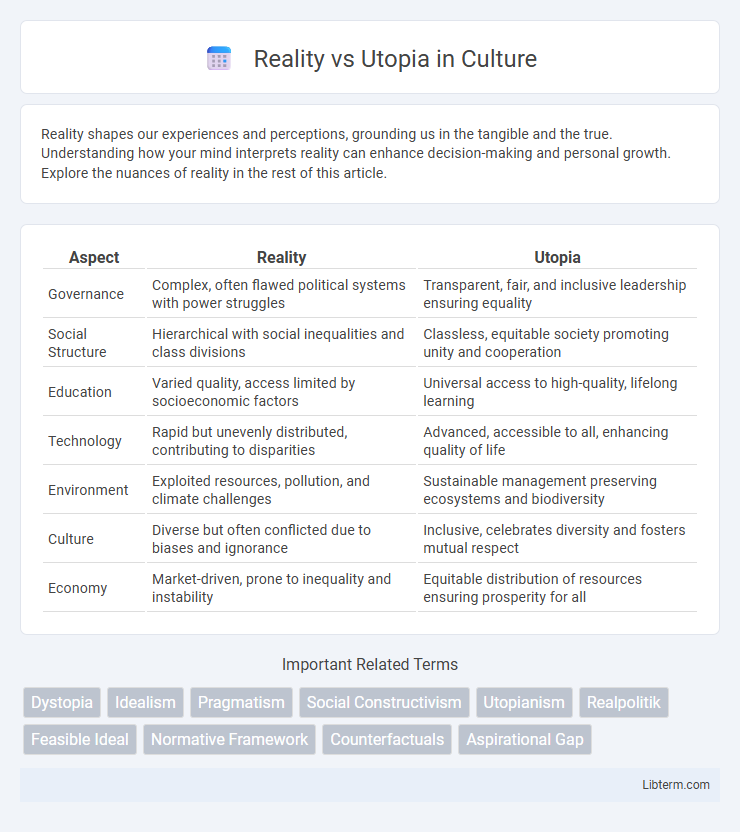Reality shapes our experiences and perceptions, grounding us in the tangible and the true. Understanding how your mind interprets reality can enhance decision-making and personal growth. Explore the nuances of reality in the rest of this article.
Table of Comparison
| Aspect | Reality | Utopia |
|---|---|---|
| Governance | Complex, often flawed political systems with power struggles | Transparent, fair, and inclusive leadership ensuring equality |
| Social Structure | Hierarchical with social inequalities and class divisions | Classless, equitable society promoting unity and cooperation |
| Education | Varied quality, access limited by socioeconomic factors | Universal access to high-quality, lifelong learning |
| Technology | Rapid but unevenly distributed, contributing to disparities | Advanced, accessible to all, enhancing quality of life |
| Environment | Exploited resources, pollution, and climate challenges | Sustainable management preserving ecosystems and biodiversity |
| Culture | Diverse but often conflicted due to biases and ignorance | Inclusive, celebrates diversity and fosters mutual respect |
| Economy | Market-driven, prone to inequality and instability | Equitable distribution of resources ensuring prosperity for all |
Understanding the Concept of Reality
Reality is the objective state of existence, governed by physical laws and measurable phenomena, contrasting with the idealized and often unattainable visions of utopia. Understanding reality requires acknowledging limitations, constraints, and the complexities of human experience within social, environmental, and economic systems. This comprehension forms the foundation for pragmatic decision-making and realistic goal-setting in contrast to the imaginative constructs of utopian ideals.
Defining Utopia: Ideals and Imagination
Utopia represents an idealized society envisioned through collective imagination, embodying perfect social, political, and moral conditions. This conceptual framework serves as a benchmark for evaluating real-world systems, highlighting gaps between current realities and aspirational goals. The ideals of utopia often emphasize equality, justice, and harmony, challenging existing societal structures to inspire progressive change.
Historical Pursuits of Utopian Societies
Historical pursuits of utopian societies, such as Thomas More's *Utopia* (1516), reflect humanity's enduring quest to design perfect social orders, often emphasizing equality, communal ownership, and moral rectitude. The 19th century saw experimental communities like New Harmony and Brook Farm, striving to implement idealistic principles amid industrial and social upheaval but frequently facing practical challenges and internal conflicts. These attempts highlight the persistent tension between utopian ideals and the complexities of human nature and real-world governance.
Contrasts Between Real-World Challenges and Utopian Dreams
Real-world challenges often involve economic inequality, political instability, and environmental degradation, which starkly contrast with utopian dreams of universal equality, perfect governance, and ecological harmony. Practical limitations such as resource scarcity, human nature, and social complexities hinder the realization of idealized societies depicted in utopian visions. These contrasts highlight the tension between aspirational goals and the constraints imposed by reality in social, political, and environmental contexts.
The Psychology Behind Utopian Thinking
Utopian thinking often stems from the psychological need to escape perceived imperfections and anxieties of reality, seeking an idealized world where all problems are resolved. Cognitive biases such as confirmation bias and optimism bias reinforce utopian beliefs by filtering information that supports ideal outcomes while dismissing negative evidence. This mental framework can motivate social progress but may also lead to disillusionment when unattainable expectations confront complex, imperfect human nature.
Social Structures: Practicality vs Perfection
Social structures in reality prioritize practicality, balancing diverse human needs, resources, and cultural differences to maintain order and functionality within societies. Utopian models envision perfect social systems characterized by ideal equality, cooperation, and the eradication of conflict, often ignoring the complexities and imperfections inherent in human behavior. The contrast highlights the challenge of designing social frameworks that are both aspirational and feasible in real-world implementation.
Technological Progress: Bridging Reality and Utopia
Technological progress accelerates the transformation of dystopian realities toward utopian ideals by enhancing communication, healthcare, and sustainable energy solutions. Innovations like artificial intelligence and renewable technologies reduce environmental impact and improve quality of life, narrowing the gap between present limitations and future possibilities. This dynamic advancement positions technology as the critical bridge uniting tangible realities with the aspirational visions of a utopian world.
Political Ideologies: Utopian Promises vs Actual Outcomes
Political ideologies often present utopian promises of equality, justice, and prosperity that contrast sharply with their actual outcomes, which frequently include power imbalances, economic disparities, and social unrest. Historical examples such as communism and socialism reveal the gap between theoretical ideals and pragmatic governance, where centralized control and authoritarianism can undermine freedoms and economic efficiency. The tension between utopian aspirations and political reality underscores the complexity of implementing idealistic visions in diverse, dynamic societies.
Cultural Narratives Shaping Utopian Aspirations
Cultural narratives deeply influence utopian aspirations by framing ideal societies through myths, literature, and collective values that reflect each culture's hopes and fears. These narratives shape visions of perfect worlds by emphasizing themes such as harmony, justice, and technological advancement, which vary across historical and social contexts. Understanding these narratives reveals how utopian ideals serve as mirrors of present realities while inspiring transformative goals for future societies.
The Future: Harmonizing Realism and Utopian Ideals
Balancing realism with utopian ideals shapes the future by integrating achievable goals and visionary aspirations to create sustainable progress. Emphasizing practical innovations alongside ethical frameworks drives societal transformation toward inclusive prosperity. The dynamic interplay of pragmatic solutions and idealistic values fosters resilient communities equipped to address emerging global challenges effectively.
Reality Infographic

 libterm.com
libterm.com